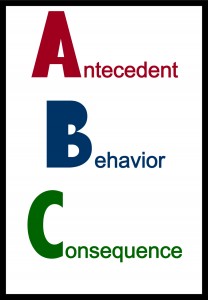Do You Know The ABC’s Of Pet Behavior?
NOTE: I have a new pet behavior blog located at http://www.SoMuchPETential.com/blog. Thanks!
(past Hyde Park Living column)
Do you know your ABC’s?
Well that’s a strange question you may be saying to yourself. Isn’t this a pet behavior column?
Yep, it sure is. And the ABC’s I’m talking about are not related to spelling words. They are instead what I have been taught to help me understand why a behavior occurs so that as a pet owner and teacher, I can effectively set my animals up for success by influencing their behavior in the most positive/least intrusive way.
Let me back up. What I really would like for you to get from this column is a basic understanding that blaming an animal for doing anything you don’t want him to do is simply counterproductive. All behavior happens because it is serving a purpose for that animal. We may never know at any given time what our animal is feeling or thinking when he jumps on us or chews up a garden hose but we don’t need to know to still set our animal up to succeed. Using the ABC assessment, we can modify the animal’s environment and modify his behavior without any use of force or punishment.
The science of behavior
Applied behavior analysis is a systematic approach to solving behavior problems by changing the environment in which the behavior occurs. It involves looking at the very specific behavior (such as a bird biting or screaming) and the related environmental context that signals and reinforces it. We ask, “What happened *immediately* prior to the behavior (antecedent) to set the whole ball rolling?“ And, “What happened *immediately* after the behavior to reinforce it (consequence)?“
 There you have it…the A (antecedent), B (behavior), and C (consequence)’s.
There you have it…the A (antecedent), B (behavior), and C (consequence)’s.
All too often when our pet is doing something we disapprove of we don’t even realize that we are responsible for reinforcing the very action we don’t want to see. Or in the heat of the moment, we end up punishing our pet – which can have detrimental side effects (the subject for a future column) and serves no teaching function.
Using the ABC assessment tool allows us to consider how we can rearrange the antecedents so that the problem behavior is never set into motion to begin with – and we can set into motion an acceptable behavior instead. Then we can reinforce the heck out of the acceptable behavior. Guess which behavior you’ll see more of?
In my next column I’ll work through a specific example of using the ABC analysis in solving a pet behavior issue.















